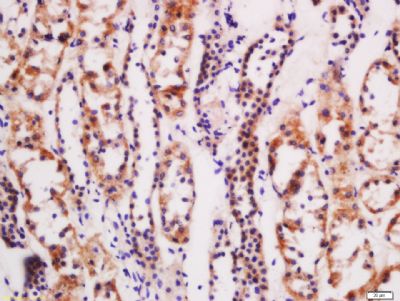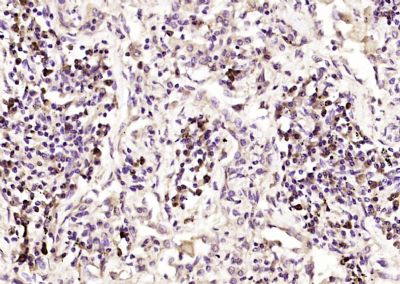CTR1 Polyclonal Antibody
Purified Rabbit Polyclonal Antibody (Pab)
- SPECIFICATION
- CITATIONS
- PROTOCOLS
- BACKGROUND

Application
| IHC-P, IHC-F, IF, ICC, E |
|---|---|
| Primary Accession | O15431 |
| Reactivity | Rat, Pig, Bovine |
| Host | Rabbit |
| Clonality | Polyclonal |
| Calculated MW | 21 KDa |
| Physical State | Liquid |
| Immunogen | KLH conjugated synthetic peptide derived from human CTR1 |
| Epitope Specificity | 51-150/190 |
| Isotype | IgG |
| Purity | affinity purified by Protein A |
| Buffer | 0.01M TBS (pH7.4) with 1% BSA, 0.02% Proclin300 and 50% Glycerol. |
| SUBCELLULAR LOCATION | Cell membrane. Localizes to the apical membrane in intestinal epithelial cells. |
| SIMILARITY | Belongs to the copper transporter (Ctr) (TC 1.A.56) family. SLC31A subfamily. |
| SUBUNIT | Homotrimer. |
| Post-translational modifications | O-Glycosylation at Thr-27 protects from proteolytic cleavage in the N-terminal extracellular domain. |
| Important Note | This product as supplied is intended for research use only, not for use in human, therapeutic or diagnostic applications. |
| Background Descriptions | The protein encoded by this gene is a high-affinity copper transporter found in the cell membrane. The encoded protein functions as a homotrimer to effect the uptake of dietary copper. [provided by RefSeq, Aug 2011] |
| Gene ID | 1317 |
|---|---|
| Other Names | High affinity copper uptake protein 1, Copper transporter 1, hCTR1, Solute carrier family 31 member 1, SLC31A1, COPT1, CTR1 |
| Dilution | IHC-P=1:100-500,IHC-F=1:100-500,ICC=1:100-500,IF=1:100-500,ELISA=1:5000-10000 |
| Format | 0.01M TBS(pH7.4), 0.09% (W/V) sodium azide and 50% Glyce |
| Storage | Store at -20 ℃ for one year. Avoid repeated freeze/thaw cycles. When reconstituted in sterile pH 7.4 0.01M PBS or diluent of antibody the antibody is stable for at least two weeks at 2-4 ℃. |
| Name | SLC31A1 (HGNC:11016) |
|---|---|
| Function | [High affinity copper uptake protein 1]: Uniporter that mediates the transport of copper(1+) from the extracellular space to the cytoplasm, across the plasma membrane (PubMed:11734551, PubMed:16135512, PubMed:17525160, PubMed:19740744, PubMed:20451502, PubMed:20569931, PubMed:23658018) and delivers directly copper(1+) to specific chaperone such as ATOX1, via a copper(1+)- mediated transient interaction between the C-terminal domain and a copper(1+) chaperone, thus controlling intracellular copper(1+) levels (PubMed:11734551, PubMed:16135512, PubMed:17525160, PubMed:19740744, PubMed:20451502, PubMed:20569931, PubMed:23658018, PubMed:26745413). May function in copper(1+) import from the apical membrane thus may drive intestinal copper absorption (By similarity). The copper(1+) transport mechanism is sodium-independent, saturable and of high-affinity (PubMed:11734551). Also mediates the uptake of silver(1+) (PubMed:20569931). May function in the influx of the platinum- containing chemotherapeutic agents (PubMed:20451502, PubMed:20569931). The platinum-containing chemotherapeutic agents uptake is saturable (By similarity). In vitro, mediates the transport of cadmium(2+) into cells (PubMed:33294387). Also participates in the first step of copper(2+) acquisition by cells through a direct transfer of copper(2+) from copper(2+) carriers in blood, such as ALB to the N-terminal domain of SLC31A1, leading to copper(2+) reduction and probably followed by copper(1+) stabilization (PubMed:30489586). In addition, functions as a redox sensor to promote angiogenesis in endothelial cells, in a copper(1+) transport independent manner, by transmitting the VEGF- induced ROS signal through a sulfenylation at Cys-189 leadin g to a subsequent disulfide bond formation between SLC31A1 and KDR (PubMed:35027734). The SLC31A1-KDR complex is then co-internalized to early endosomes, driving a sustained VEGFR2 signaling (PubMed:35027734). |
| Cellular Location | Cell membrane; Multi-pass membrane protein. Early endosome membrane; Multi-pass membrane protein. Recycling endosome membrane; Multi-pass membrane protein. Apical cell membrane {ECO:0000250|UniProtKB:Q8K211}; Multi-pass membrane protein. Late endosome membrane {ECO:0000250|UniProtKB:Q8K211}; Multi-pass membrane protein. Basolateral cell membrane {ECO:0000250|UniProtKB:Q8K211}; Multi-pass membrane protein. Note=The localization is controlled by the intra and extra-cellular copper concentration (PubMed:15326162, PubMed:19740744, PubMed:23658018, PubMed:26205368, PubMed:26945057). Under conditions of elevated extracellular copper concentrations, it is rapidly internalized by endocytosis from the plasma membrane by a clathrin- and dynamin-mediated process and degradated in order to prevent intracellular copper accumulation and to reduce the transport of the copper across the membrane (PubMed:15326162, PubMed:19740744, PubMed:23658018, PubMed:26205368, PubMed:26945057). The internalized SLC31A1 is then localized in early endosomes, and, upon a low extracellular copper concentrations, it is transported back to the plasma membrane in a RAB11A-dependent recycling pathway (PubMed:26945057). Localizes to the apical membrane in intestinal epithelial cells (By similarity). Mainly localized on the basolateral side of renal tubular cells (By similarity). Localizes to the neuronal cell body plasma membranes (By similarity) {ECO:0000250|UniProtKB:Q8K211, ECO:0000250|UniProtKB:Q9JK41, ECO:0000269|PubMed:15326162, ECO:0000269|PubMed:19740744, ECO:0000269|PubMed:23658018, ECO:0000269|PubMed:26205368, ECO:0000269|PubMed:26945057} |

Thousands of laboratories across the world have published research that depended on the performance of antibodies from Abcepta to advance their research. Check out links to articles that cite our products in major peer-reviewed journals, organized by research category.
info@abcepta.com, and receive a free "I Love Antibodies" mug.
Provided below are standard protocols that you may find useful for product applications.
If you have used an Abcepta product and would like to share how it has performed, please click on the "Submit Review" button and provide the requested information. Our staff will examine and post your review and contact you if needed.
If you have any additional inquiries please email technical services at tech@abcepta.com.













 Foundational characteristics of cancer include proliferation, angiogenesis, migration, evasion of apoptosis, and cellular immortality. Find key markers for these cellular processes and antibodies to detect them.
Foundational characteristics of cancer include proliferation, angiogenesis, migration, evasion of apoptosis, and cellular immortality. Find key markers for these cellular processes and antibodies to detect them. The SUMOplot™ Analysis Program predicts and scores sumoylation sites in your protein. SUMOylation is a post-translational modification involved in various cellular processes, such as nuclear-cytosolic transport, transcriptional regulation, apoptosis, protein stability, response to stress, and progression through the cell cycle.
The SUMOplot™ Analysis Program predicts and scores sumoylation sites in your protein. SUMOylation is a post-translational modification involved in various cellular processes, such as nuclear-cytosolic transport, transcriptional regulation, apoptosis, protein stability, response to stress, and progression through the cell cycle. The Autophagy Receptor Motif Plotter predicts and scores autophagy receptor binding sites in your protein. Identifying proteins connected to this pathway is critical to understanding the role of autophagy in physiological as well as pathological processes such as development, differentiation, neurodegenerative diseases, stress, infection, and cancer.
The Autophagy Receptor Motif Plotter predicts and scores autophagy receptor binding sites in your protein. Identifying proteins connected to this pathway is critical to understanding the role of autophagy in physiological as well as pathological processes such as development, differentiation, neurodegenerative diseases, stress, infection, and cancer.



